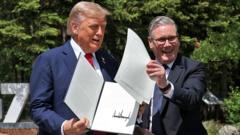Today's election results will define Canada's governmental direction amidst economic upheaval and shifting political landscapes.
Canada at a Crossroads: The Election that Could Reshape Its Future

Canada at a Crossroads: The Election that Could Reshape Its Future
Canada heads to the polls in a pivotal election fraught with tension from external pressures and domestic fatigue with the current leadership.
Canadians are casting their votes today, April 28, 2025, in a crucial election that could redefine the nation’s leadership and its response to challenges posed by President Trump. Polling data indicates a competitive race between the Liberal Party, led by newly appointed Prime Minister Mark Carney, and the Conservative Party under the leadership of Pierre Poilievre. The election outcome could either reflect a continuation of the Liberal governance or signal a return to Conservative control after a decade in opposition.
In the lead-up to this election, the political landscape shifted dramatically due to the recent resignation of former Prime Minister Justin Trudeau and the tumult caused by Trump's trade tariffs and threats of annexation. Once holding a decisive lead, the Conservative Party now finds itself neck-and-neck with the Liberals, thanks to renewed support for Carney, who aims to position himself as a stabilizing force against U.S. pressures.
Canadians are often reminded of the parliamentary voting system wherein they elect representatives to their local districts, with the party accumulating the most seats ultimately forming the government. This election will fill 343 parliamentary seats, and the political implications stretch across various prominent regional concerns, particularly surrounding U.S.-Canada relations and economic stability.
Additionally, the election features smaller parties like the New Democratic Party, the Greens, and the Bloc Quebecois, though their influence is expected to be minimal. The campaign has seen intensifying debates over tariffs affecting the automotive industry and the economic fallout they have generated. Voter engagement is high; over seven million Canadians have completed advance voting ahead of this pivotal moment.
The candidates present differing visions: Carney, a central banker turned politician, promises to leverage his extensive economic expertise to counteract Trump's tariffs and restore Canadian sovereignty. Conversely, Poilievre emphasizes reducing government size and regulation, reflecting a more populist approach that some perceive as reminiscent of Trump himself.
As the ballots are cast, attention will turn to the responding impacts of Trump’s policies on Canada’s economy and how the new leader's vision aligns with the public's desire for change amid persistent inflation and rising living costs. Polls will close tonight at 9:30 p.m. ET, and the results will gradually be disclosed, shaping the landscape of Canadian politics for the foreseeable future.
In the lead-up to this election, the political landscape shifted dramatically due to the recent resignation of former Prime Minister Justin Trudeau and the tumult caused by Trump's trade tariffs and threats of annexation. Once holding a decisive lead, the Conservative Party now finds itself neck-and-neck with the Liberals, thanks to renewed support for Carney, who aims to position himself as a stabilizing force against U.S. pressures.
Canadians are often reminded of the parliamentary voting system wherein they elect representatives to their local districts, with the party accumulating the most seats ultimately forming the government. This election will fill 343 parliamentary seats, and the political implications stretch across various prominent regional concerns, particularly surrounding U.S.-Canada relations and economic stability.
Additionally, the election features smaller parties like the New Democratic Party, the Greens, and the Bloc Quebecois, though their influence is expected to be minimal. The campaign has seen intensifying debates over tariffs affecting the automotive industry and the economic fallout they have generated. Voter engagement is high; over seven million Canadians have completed advance voting ahead of this pivotal moment.
The candidates present differing visions: Carney, a central banker turned politician, promises to leverage his extensive economic expertise to counteract Trump's tariffs and restore Canadian sovereignty. Conversely, Poilievre emphasizes reducing government size and regulation, reflecting a more populist approach that some perceive as reminiscent of Trump himself.
As the ballots are cast, attention will turn to the responding impacts of Trump’s policies on Canada’s economy and how the new leader's vision aligns with the public's desire for change amid persistent inflation and rising living costs. Polls will close tonight at 9:30 p.m. ET, and the results will gradually be disclosed, shaping the landscape of Canadian politics for the foreseeable future.





















